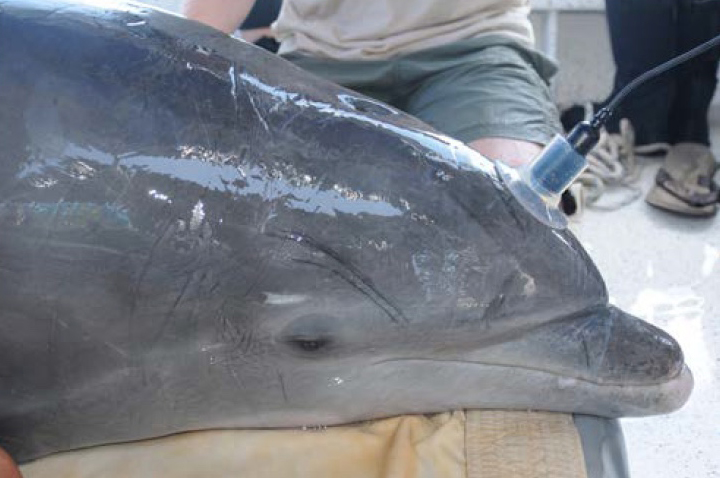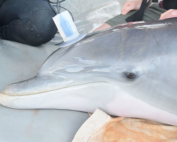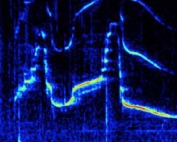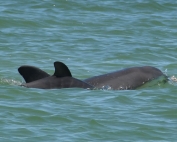Dolphin Communication Studies

A non-invasive suction-cup hydrophone is used to record whistles made by dolphin F146.
SDRP conducts the world’s longest-running study of a wild dolphin population, initiated in 1970. Information available from five decades of research on the multi-decadal, multi-generational, year-round resident community of individually identifiable bottlenose dolphins of Sarasota Bay established this as a unique natural laboratory for learning about the biology, behavior, ecology, social structure, health, and communication of dolphins, as well as the effects of human activities on them.
Long-term study is crucial for understanding the lives of members of long-lived species such as bottlenose dolphins, and for being able to detect trends in populations relative to changes in their environment. Knowing the long-term geographic range of a population unit allows the measurement of exposure to threats, which in turn facilitates mitigation, including direct interventions.
The ability to observe identifiable individual dolphins of known sex, age, and familial relationships through all of their life history milestones and associated transitions in behavioral and social patterns, to collect data on health and condition, and to then document their reproductive success and cause of death is rare in cetacean research.
The depth of background knowledge about each member of the locally resident “cast of characters” guides research and facilitates interpretation of data on communication.
Data are collected through a variety of techniques, including acoustic recordings and whistle playback experiments during periodic health assessments, focal animal behavioral observations with acoustic monitoring, tagging with digital acoustic archival tags (DTAGs), and passive acoustic monitoring from shore-based listening stations.
Communication studies have been led by scientists from Woods Hole Oceanographic Institution and the University of St. Andrews, Scotland. Among the more interesting findings has been confirmation of the existence of individually specific signature whistles, and how these whistles are used as identifiers, similar to how humans use names.
Studies over the past few decades in Sarasota Bay have helped immensely to develop our understanding of how dolphins use whistles to communicate with one another. Identifying which animal is vocalizing continues to be one of the greatest challenges for research on cetacean communication, but the SDRP health assessments have enabled us to build up a library of whistles.
So far, the Sarasota Dolphin Whistle Database contains 926 recording sessions of 293 individual dolphins; we know the age, sex and the matrilineage for most of them. The cover of our 2022 annual report, Nicks ‘n’ Notches, showed a visual representation of the signature whistles of all 269 Sarasota Bay dolphins that have been recorded, prepared by our colleague Frants Jensen.
About 108 dolphins have been recorded only one time, and the remaining 60% have been recorded between two and 16 times, with an average of 4.7 recording sessions per individual (for those recorded more than once), over periods two to 31 years. (You can listen to some of these recordings in our “Meet the Dolphins” section.) The longest time span over which an individual has been recorded is 43 years, and 85 individuals have been recorded over a decade or more.
Adding to the value of these recordings is the fact that we have so much detailed, long-term, background information about the animals, including their sex, age, relatedness to other animals, and social associations over periods of decades in some cases.
For example, we have recorded more than 100 mother-calf pairs (some of the mothers have been recorded with multiple calves). This whistle archive is unique and immensely valuable for studies of many aspects of dolphin communication, including whistle structure, development, stability, and functions, and we have used these whistles as stimuli in a long-term set of ongoing playback experiments.
The dolphin communication team includes Drs. Laela Sayigh, Woods Hole Oceanographic Institution and Vincent Janik, University of St. Andrews, Doug Nowacheck, Duke University, Michael Scott, Inter-American Tropical Tuna Commission, and Stephanie Watwood, U.S. Navy.
Research is conducted under a series of Scientific Research Permits issued by NOAA’s National Marine Fisheries Service, and annual renewals of Institutional Animal Care and Use Committee approvals by Mote Marine Laboratory.
Whistling Away in Sarasota Bay
To record dolphin sounds, we place non-invasive hydrophones mounted on suction cups on a dolphin’s melon (“forehead”) and record the sounds that they make. We’ve been recording dolphin whistles since the 1970s.
Dolphins Have Names
Did you know that bottlenose dolphins develop individually distinctive signature whistles that they use to maintain group cohesion? Unlike the development of identification signals in most other species, signature whistle development is strongly influenced
Listening to Sarasota Bay Dolphins
Dolphin F197 with her fourth calf, 1974. Several members of F197's family like to swim near the Cortez PAL station. Listening in on Sarasota Bay Dolphins' Underwater World The SDRP, working







